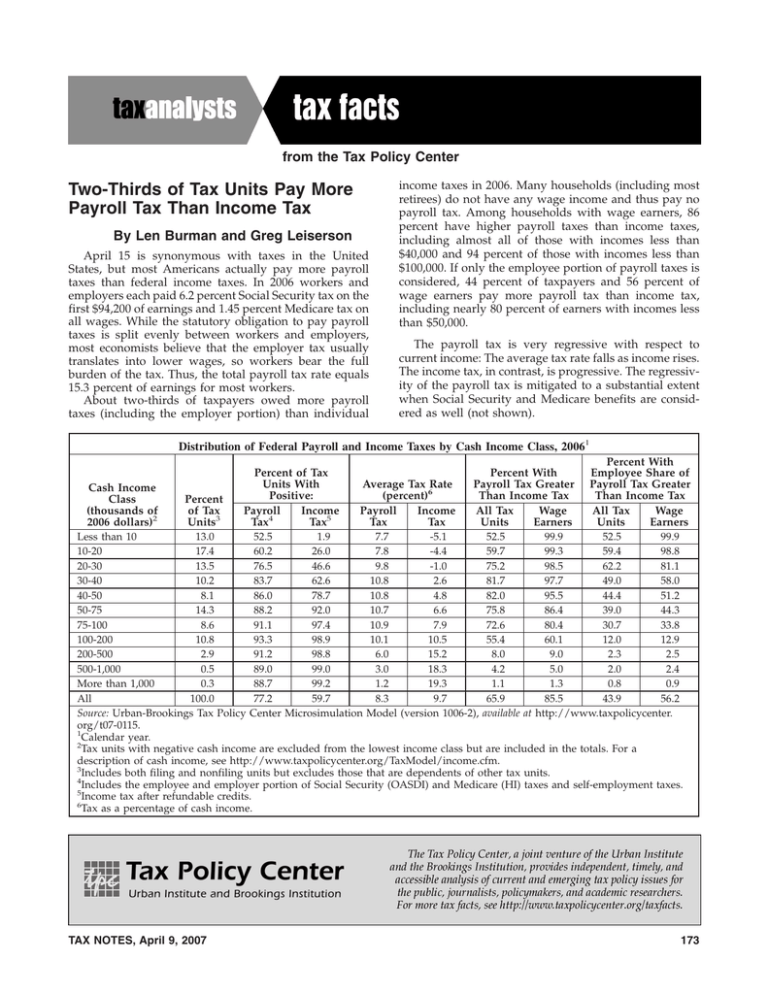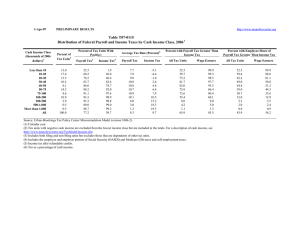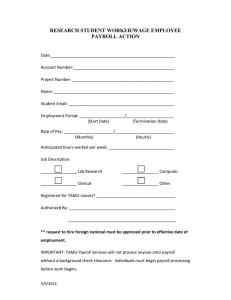Two-Thirds of Tax Units Pay More
advertisement

from the Tax Policy Center Two-Thirds of Tax Units Pay More Payroll Tax Than Income Tax By Len Burman and Greg Leiserson April 15 is synonymous with taxes in the United States, but most Americans actually pay more payroll taxes than federal income taxes. In 2006 workers and employers each paid 6.2 percent Social Security tax on the first $94,200 of earnings and 1.45 percent Medicare tax on all wages. While the statutory obligation to pay payroll taxes is split evenly between workers and employers, most economists believe that the employer tax usually translates into lower wages, so workers bear the full burden of the tax. Thus, the total payroll tax rate equals 15.3 percent of earnings for most workers. About two-thirds of taxpayers owed more payroll taxes (including the employer portion) than individual income taxes in 2006. Many households (including most retirees) do not have any wage income and thus pay no payroll tax. Among households with wage earners, 86 percent have higher payroll taxes than income taxes, including almost all of those with incomes less than $40,000 and 94 percent of those with incomes less than $100,000. If only the employee portion of payroll taxes is considered, 44 percent of taxpayers and 56 percent of wage earners pay more payroll tax than income tax, including nearly 80 percent of earners with incomes less than $50,000. The payroll tax is very regressive with respect to current income: The average tax rate falls as income rises. The income tax, in contrast, is progressive. The regressivity of the payroll tax is mitigated to a substantial extent when Social Security and Medicare benefits are considered as well (not shown). Distribution of Federal Payroll and Income Taxes by Cash Income Class, 20061 Cash Income Class (thousands of 2006 dollars)2 Percent of Tax Units3 Percent of Tax Units With Positive: Payroll Income Tax4 Tax5 Average Tax Rate (percent)6 Payroll Income Tax Tax Percent With Payroll Tax Greater Than Income Tax All Tax Wage Units Earners Percent With Employee Share of Payroll Tax Greater Than Income Tax All Tax Wage Units Earners Less than 10 13.0 52.5 1.9 7.7 -5.1 52.5 99.9 52.5 99.9 10-20 17.4 60.2 26.0 7.8 -4.4 59.7 99.3 59.4 98.8 20-30 13.5 76.5 46.6 9.8 -1.0 75.2 98.5 62.2 81.1 30-40 10.2 83.7 62.6 10.8 2.6 81.7 97.7 49.0 58.0 40-50 8.1 86.0 78.7 10.8 4.8 82.0 95.5 44.4 51.2 50-75 14.3 88.2 92.0 10.7 6.6 75.8 86.4 39.0 44.3 75-100 8.6 91.1 97.4 10.9 7.9 72.6 80.4 30.7 33.8 100-200 10.8 93.3 98.9 10.1 10.5 55.4 60.1 12.0 12.9 200-500 2.9 91.2 98.8 6.0 15.2 8.0 9.0 2.3 2.5 500-1,000 0.5 89.0 99.0 3.0 18.3 4.2 5.0 2.0 2.4 More than 1,000 0.3 88.7 99.2 1.2 19.3 1.1 1.3 0.8 0.9 All 100.0 77.2 59.7 8.3 9.7 65.9 85.5 43.9 56.2 Source: Urban-Brookings Tax Policy Center Microsimulation Model (version 1006-2), available at http://www.taxpolicycenter. org/t07-0115. 1 Calendar year. 2 Tax units with negative cash income are excluded from the lowest income class but are included in the totals. For a description of cash income, see http://www.taxpolicycenter.org/TaxModel/income.cfm. 3 Includes both filing and nonfiling units but excludes those that are dependents of other tax units. 4 Includes the employee and employer portion of Social Security (OASDI) and Medicare (HI) taxes and self-employment taxes. 5 Income tax after refundable credits. 6 Tax as a percentage of cash income. TAX NOTES, April 9, 2007 173

